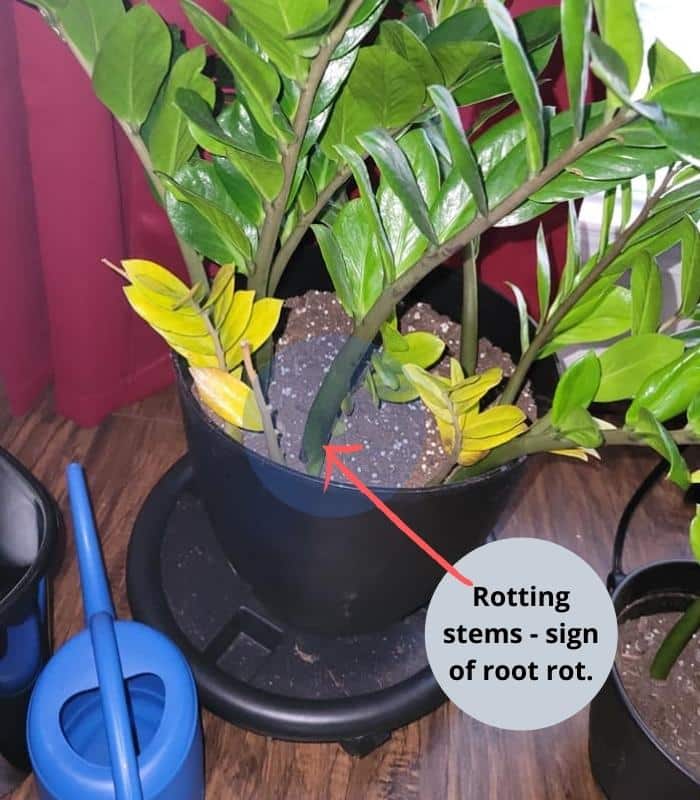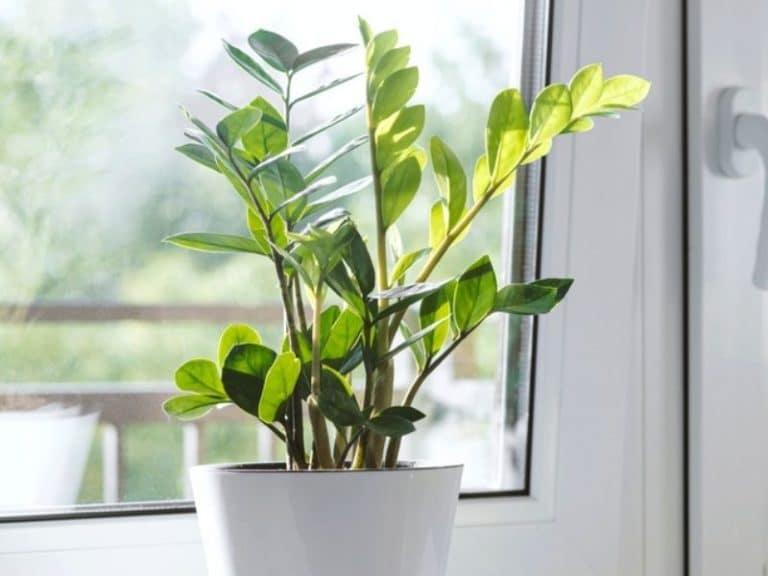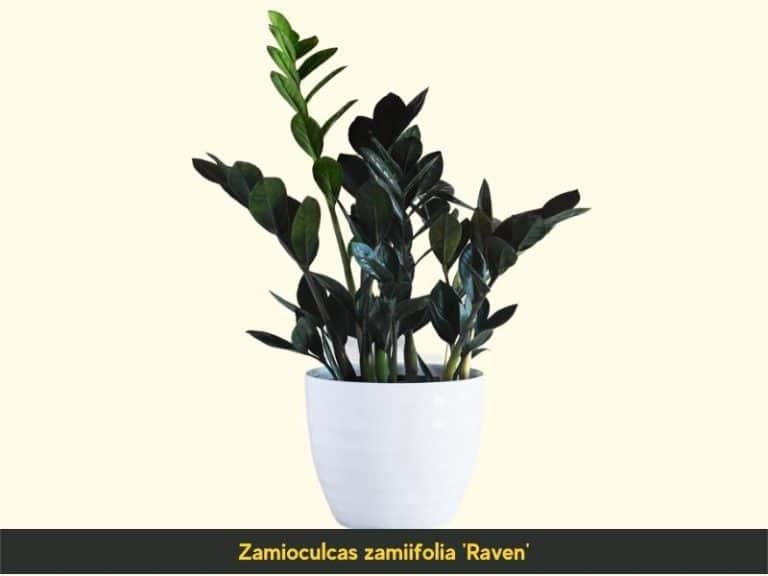Overwatered ZZ Plant: Signs + How to Save the Plant
A ZZ plant doesn’t need water unless the soil it grows on is completely dry. Overwatering can happen due to the soil mix, type of pot, and watering malpractices. The easiest way to revive an overwatered ZZ plant is improving drainage in the pot and reducing the frequency of watering.
Once you address the issues in your zz care program, your plant will bounce back with green, healthy foliage.
Can you overwater your ZZ plant?
If you’re like most houseplant owners, it’s possible to give your ZZ plant excess water than it requires out of goodwill. Perhaps you suspect that it’s been long since you gave it a drink and overwatering it may be your way of correcting the neglect.

ZZ plants don’t need frequent or excess watering. Surprisingly, Zanzibar gems need less water than the average indoor plant because their rhizomes store the water for extended periods. Consequently, overwatering is the shortest way of killing them.
Overwatering a ZZ plant comes as a result of the following factors:
The type of pot
ZZs in plastic pots and other nonporous pots without drainage holes are more prone to overwatering because these materials don’t encourage prompt drainage. It’s more likely that the plant’s roots will get saturated with water and drown hence struggling to draw in oxygen and nutrients. It’s either you poke some holes around and at the base of the (for plastics) container or pot them in a porous container like clay or terracotta to address the overwatering issue.
The soil mix
Poorly drained soils also encourage overwatering. While these plants can tolerate many soil types, they will hardly survive in poorly drained soils. A ZZ plant in such soils will become so saturated with water that it will struggle to breathe. You’ll know the soil mix you’ve planted your ZZ in is unsuitable if:
- The ZZ plant’s leaves turn yellow to brown
- The leaves curl
- The rhizomes develop root rot
- The stems shrivel or wilt
The best soil ingredients you should consider for a ZZ plant are sand or perlite and a premixed blend of cactus potting mix. The mix should also have a pH range of 6.0-7.0.
Your watering schedule
While you have set a tight watering schedule for your plant, this can lead to disappointments as long as you’ve not taken account of its condition. These plants resemble regular houseplants like dandelions, so you might think it needs excess watering to maintain their greenness and health, but their growing conditions are different.
Your ZZ’s rhizomes have efficient water and food storage system that releases to the plant on a need-be basis. These tubular structures are normally sturdy and white, resembling small Irish potatoes. However, they can become soft and brown when overwatered.
The fundamental rule of watering a ZZ plant is when the top 1 or 2-inches of soil is completely dry. Your watering schedule should ape the plant’s natural habitat, Eastern Africa. Start testing the soil for dryness by poking your fingers or using a soil moisture meter.
Alternatively, lift the pot and poke the drainage holes at the base. If the soil on the bottom part of the pot is dry, give it some water.
Signs of overwatering in ZZ plants

The signs of overwatered ZZ plants might be similar to those infected by diseases or exposed to too much direct sunlight. Therefore, watch out for these signs to be sure your plant is rebelling from any other issue besides overwatering:
Root rot
Like any other plant, an overwatered ZZ plant is susceptible to root rot. Its rhizomes act as water reservoirs that release food and water to other plant parts for energy production. Establishing if it’s rotting due to overwatering or fungal infection works by plucking it out to examine its rhizomes.
Touch the rhizomes; are they mushy instead of robust? Are they brown instead of white? Does it have a rotten smell? If yes, then its rhizomes have started drowning due to excess water.
Root rot is also a sign of a fungal infection. Since fungi thrive in a moist environment, excess water in the planter encourages their growth and multiplication. However, the best way to differentiate the two is by rinsing the rhizomes with water. If drooping stems accompany the rot, address the overwatering issue first.
Shriveling stems
Start by checking the thick parts of the stem near the soil. If they appear shriveled and have burnt spots, the plant could be reacting to excess water.
Mushy stems with black spots
Touch the stems to determine if they are soft or turgid. The softness signifies excess water, which the plant is struggling to contain. While it’s natural for ZZs to have black spots on their stems, too much of it, accompanied by mushiness, comes from excess water.
Small dark spots on leaves
An overwatered ZZ plant will also have yellow spots slowly turning black. The problem comes when the excess water allows fungi or bacteria in the soil to multiply and infest the plant.
How to Save an Overwatered ZZ Plant
Saving an overwatered ZZ plant works by inspecting your plant and addressing the issue before it escalates beyond your control. Depending on the signs you’ve gathered, here are some helpful tips you can apply to salvage your plant:
1. Use a porous pot
The easiest way to have peace of mind knowing your plant won’t suffer overwatering mishaps in the future is repotting it in a permeable or porous pot. But if that isn’t an option, create a hole at the bottom for fast draining as you plan to buy the porous pot for your plant.
2. Change to a fast-draining soil after drying out the plant
It’s improbable to save an overwatered ZZ plant unless you completely dry it out and repot it in fresh and dry soil. The root rot issue may worsen if you leave it on the waterlogged soil.
Also, the soil might have too much fungi or bacteria. Make sure you use fresh, readily mixed cactus soil and perlite or coarse sand to repot your plant because the combination has fast-draining and aeration characteristics.
3. Treat root rot
It’s not easy spotting what’s going on underneath the soil to establish if the plant has a root rot issue. Probably, the leaves turn yellow to brown, which droop should signal you of root rot. Therefore, to address the root rot, follow these steps:
- Uproot the plant from its pot. You can use a serrated knife to carve out the soil around the pot, ensuring you don’t cut the plant’s roots in the process.
- Run water on the rhizomes to reveal the root rot
- Cut off the diseased roots and rhizomes that appear brown and soggy
- Repot the plant in fresh fast-draining soil (cactus mix)
- Make sure to water it only when the first- or second-inches topsoil is completely dry
If the plant doesn’t bounce back in a week or two, consider propagation through healthy stems and leaves.
4. Prune dead and diseased leaves and stems
As long as you leave the dead leaves and stems, they will compete with other healthy parts of the plant for energy. The only solution you have is pruning them using a sterilized knife or clipper. Should the overwatering extend to a rhizome of a dead stem, gently tug it out.
5. Adjust the watering schedule
A ZZ plant can be forgiving if you don’t return to your old watering malpractices. Your watering schedule should be as follows:
- Only water the plant when the 1-2 inches topsoil is dry. Use a soil moisture meter to test moisture in the soil accurately.
- Water the soil from the bottom first for about a minute. It works by running some water on a sink then placing the pot on it. The drainage hole at the base will draw in water first through capillary action. Next, remove the pot from the sink and place it in a tray to drain excess water.
- Limit watering during winter to once a month
- In summer, spring, and autumn, only water the plant when it’s completely dry.
Here’s a video on common problems and solutions with Zz plants:
READ NEXT: DIFFERENT VARIETIES OF THE ZZ PLANT





Thanks for the help, really appreciate it.